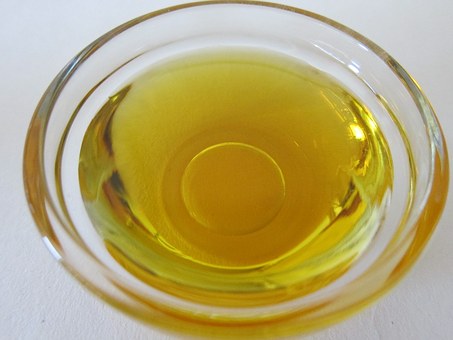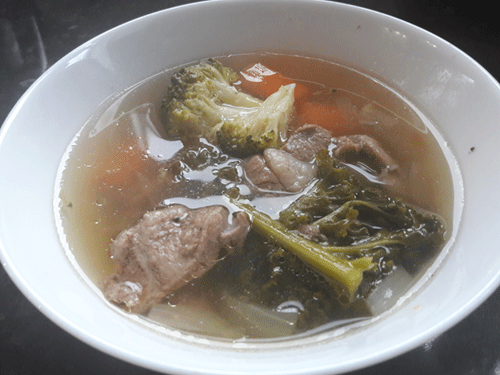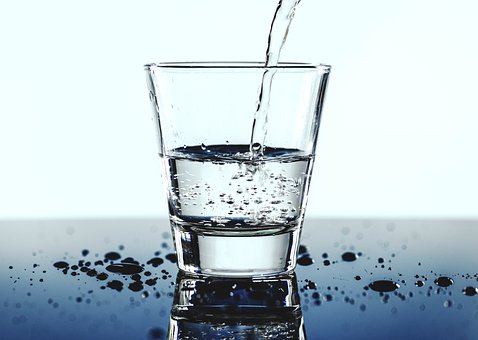The Big Fat Con: Saturated Fat and Cholesterol
© HealthyMuslim. See Terms and Conditions

The man responsible for the dietary cholesterol and saturated-fat hypothesis, Ancel Keys, had data from 22 countries, which collectively, showed absolutely no correlation between high saturated fat intake and heart disease. In fact in different countries different results were obtained. Heart attacks occurred in countries where saturated fat intake was high and low - there was no difference. Then Mr. Keys did the classic of kicking out all the data that would not fit the hypothesis - so he reduced the countries down to 7, selecting them so that he managed to get a fairly straight line indicating an association between high saturated fat intake and heart disease. Thus, based on this "hypothesis" the "low-fat" propaganda was unleashed and continues three or four decades later. Yet despite all the hundreds of millions of people lowering their fat-intake, heart attacks and heart disease have increased in all nations having the typical Western diet of processed foods.
Peoples, nations, societies and cultures have been consuming saturated fats for thousands of years. The epidemic levels of heart disease only occurred well into the twentieth century.
Heart disease is a new problem. It is not caused by old, traditional diets. It is caused by new foods that were not consumed before. That is a plain simple fact. This will be elaborated upon in future articles inshaa'Allaah.
First a paper published in the European heart Journal in 1997.
L. A. CORR. Guys' and St. Thomas' Hospitals. M. F. OLIVER. National heart and Lung Institute. London, U.K. The low fat/low cholesterol diet is ineffective. European heart Journal (1997) 18, 18-22.
Conclusions. The commonly-held belief that the best diet for prevention of coronary heart disease is a low saturated fat, low cholesterol diet is not supported by the available evidence from clinical trials. In primary prevention, such diets do not reduce the risk of myocardial infarction or coronary or all-cause mortality. Cost-benefit analyses of the extensive primary prevention programmes, which are at present vigorously supported by Governments, health Departments and health educationalists, are urgently required. Similarly, diets focused exclusively on reduction of saturated fats and cholesterol are relatively ineffective for secondary prevention and should be abandoned.
And another study raising a similar issue:
Reiser R. Oversimplification of diet: coronary heart disease relationships and exaggerated diet recommendations. Am J Clin Nutr. 1978 May;31(5):865-75.
The data relating diet to coronary heart disease, when critically examined, clearly show that there is a normal spectrum of blood serum values, and that normal persons do not develop pathological levels upon the ingestion of eggs and the ingestion of large amounts of cholesterol-containing foods. Average data obtained from mixed populations of normal and pathological blood lipid values should not be used to advise the normal majority of that population. The harmful effects of such policy are outlined. The data demonstrating the concept that the risk of coronary heart disease is a function of serum lipids at any level is no longer valid are reviewed. The data of the National Cooperative Pooling Project of the American heart Association are used to show that up to 250 mg/dl there is no relationship between serum cholesterol concentration and risk.
Then another paper published in the Journal of the American College of Cardiology:
Sylvan Lee Weinberg, MD, MACC. The Diet-Heart Hypothesis: A Critique. Journal of the American College of Cardiology. Vol. 43, No. 5:731-3 2004
The low-fat "diet-heart hypothesis" has been controversial for nearly 100 years. The low-fat-high-carbohydrate diet, promulgated vigorously by the National cholesterol Education Program, National Institutes of health, and American heart Association since the Lipid Research Clinics-Primary Prevention Program in 1984, and earlier by the U.S. Department of Agriculture food pyramid, may well have played an unintended role in the current epidemics of obesity, lipid abnormalities, type II diabetes, and metabolic syndromes. This diet can no longer be defended by appeal to the authority of prestigious medical organizations or by rejecting clinical experience and a growing medical literature suggesting that the much-maligned low-carbohydrate-high-protein diet may have a salutary effect on the epidemics in question.
Another study published in the JAMA (Journal of the American Medical Association) in 2006:
Barbara V. Howard, PhD et. al. [long list of names omitted]. Low-Fat Dietary Pattern and Risk of cardiovascular disease. The Women's health Initiative Randomized Controlled Dietary Modification Trial. JAMA Vol. 295 No. 6, February 8, 2006.
Context Multiple epidemiologic studies and some trials have linked diet with cardiovascular disease (CVD) prevention, but long-term intervention data are needed.
Objective To test the hypothesis that a dietary intervention, intended to be low in fat and high in vegetables, fruits, and grains to reduce cancer, would reduce CVD risk.
Design, Setting, and Participants Randomized controlled trial of 48 835 postmenopausal women aged 50 to 79 years, of diverse backgrounds and ethnicities, who participated in the Women's health Initiative Dietary Modification Trial. Women were randomly assigned to an intervention (19 541 [40%]) or comparison group (29 294 [60%]) in a free-living setting. Study enrollment occurred between 1993 and 1998 in 40 US clinical centers; mean follow-up in this analysis was 8.1 years.
Intervention Intensive behavior modification in group and individual sessions designed to reduce total fat intake to 20% of calories and increase intakes of vegetables/fruits to 5 servings/d and grains to at least 6 servings/d. The comparison group received diet-related education materials.
Main Outcome Measures Fatal and nonfatal coronary heart disease (CHD), fatal and nonfatal stroke, and CVD (composite of CHD and stroke).
Results By year 6, mean fat intake decreased by 8.2% of energy intake in the intervention vs the comparison group, with small decreases in saturated (2.9%), monounsaturated (3.3%), and polyunsaturated (1.5%) fat; increases occurred in intakes of vegetables/fruits (1.1 servings/d) and grains (0.5 serving/d). Low-density lipoprotein cholesterol levels, diastolic blood pressure, and factor VIIc levels were significantly reduced by 3.55 mg/dL, 0.31 mm Hg, and 4.29%, respectively; levels of high-density lipoprotein cholesterol, triglycerides, glucose, and insulin did not significantly differ in the intervention vs comparison groups. The numbers who developed CHD, stroke, and CVD (annualized incidence rates) were 1000 (0.63%), 434 (0.28%), and 1357 (0.86%) in the intervention and 1549 (0.65%), 642 (0.27%), and 2088 (0.88%) in the comparison group. The diet had no significant effects on incidence of CHD (hazard ratio [HR], 0.97; 95% confidence interval [CI], 0.90-1.06), stroke (HR, 1.02; 95% CI, 0.90-1.15), or CVD (HR, 0.98; 95% CI, 0.92-1.05). Excluding participants with baseline CVD (3.4%), the HRs (95% CIs) for CHD and stroke were 0.94 (0.86-1.02) and 1.02 (0.90-1.17), respectively. Trends toward greater reductions in CHD risk were observed in those with lower intakes of saturated fat or trans fat or higher intakes of vegetables/fruits.
Conclusions Over a mean of 8.1 years, a dietary intervention that reduced total fat intake and increased intakes of vegetables, fruits, and grains did not significantly reduce the risk of CHD, stroke, or CVD in postmenopausal women and achieved only modest effects on CVD risk factors, suggesting that more focused diet and lifestyle interventions may be needed to improve risk factors and reduce CVD risk.
And from the very end of this paper, in the discussion, there occurs:
In conclusion, this long-term dietary intervention in postmenopausal women, intended to reduce fat intake and increase intake of vegetables, fruits, and grains, achieved an 8.2% of energy decrease in total fat intake but only a 2.9% of energy decrease in saturated fat intake and only modest increases in intakes of vegetables, fruits, and grains. The intervention did not reduce risk of CHD or stroke. To achieve a significant public health impact on CVD events, a greater magnitude of change in multiple macronutrients and micronutrients and other behaviors that influence CVD risk factors may be necessary.
In other words, saturated fat reduction did not show any significant betterment and that a wider range of influential nutrients and behaviours need to be studied.
If its not saturated fats and dietary cholesterol that can be pinpointed, what is it? The accumulating clinical evidence strongly suggests it is trans-fats and refined and hydrolyzed (hydrogenated) vegetable oils, margarines, oxidized polyunsaturated fats (whether natural or as a result of cooking and preparatory processes, or which become oxidized in the body), a high omega-6:omega-3 ratio (in the US for example it is around 17:1, when ideally it should be around 4:1 or thereabouts), high sugar intake, a gross deficiency of Vitamin C and other antioxidants in the body - leading to excess free radicals, as well as lifestyle issues that are major factors involved in heart disease.
In addition, an exaggerated and prolonged inflammatory process (which is the immune system's response) to certain triggers (which can be infections, or even stress) can set off a process that can lead to sudden heart attacks - in people with perfectly normal cholesterol levels.
As for trans fats:
Gary P. Zaloga, MD, Kevin A. Harvey, MS, William Stillwell, PhD and Rafat Siddiqui, PhD. Methodist Research Institute of Clarian health Partners, Indiana University School of medicine, and Department of Biology of Indiana University Purdue University at Indianapolis, Indianapolis, Indiana. Trans fatty acids and Coronary heart Disease. Nutrition in Clinical Practice, Vol. 21, No. 5, 505-512 (2006).
Epidemiologic evidence has linked trans fatty acids (TFAs) in the diet to coronary heart disease in human populations. It has been estimated that dietary TFAs from partially hydrogenated oils may be responsible for between 30,000 and 100,000 premature coronary deaths per year in the United States. Although it is known that TFAs increase low-density lipoprotein (LDL) cholesterol levels and decrease high-density lipoprotein (HDL) cholesterol levels (markers of coronary heart disease), there is little known about the mechanisms by which TFAs actually function at the cellular level. It is unknown what levels of TFAs are clinically significant and it is unclear how TFAs are associated with cardiac arrhythmias or sudden cardiac death. We hypothesize that TFAs affect membrane structure, thus altering enzymatic pathways that may subsequently induce cardiac arrhythmias and sudden death.
Nicole M. de Roos, Evert G. Schouten and Martijn B. Katan. Consumption of a Solid fat Rich in Lauric acid Results in a More Favorable Serum Lipid Profile in Healthy Men and Women than Consumption of a Solid fat Rich in trans-Fatty Acids. Journal of nutrition. 2001;131:242-245.
Solid fats are used in food manufacturing to provide texture and firmness to foods. Such fats are rich in either saturated or trans-fatty acids, both of which increase the risk of coronary heart disease. Epidemiological and experimental studies suggest that trans-fatty acids increase risk more than do saturates because they lower serum high density lipoprotein (HDL) cholesterol. However, there appear to be differences between saturates in their effect on HDL cholesterol. We investigated whether the consumption of a solid fat rich in lauric acid (C12:0) would result in a more favorable blood lipid profile than the consumption of a solid fat rich in trans-fatty acids...Consumption of a solid fat rich in lauric acid gives a more favorable serum lipoprotein pattern than consumption of partially hydrogenated soybean oil rich in trans-fatty acids. Thus, solid fats rich in lauric acids, such as tropical fats, appear to be preferable to trans-fats in food manufacturing, where hard fats are indispensable.
This next study indicates that its polyunsaturated fatty acids (of which vegetable oils are a source) that are found in plaques.
Felton CV, Crook D, Davies MJ, Oliver MF. Wynn Institute for Metabolic Research, London, UK. Dietary polyunsaturated fatty acids and composition of human aortic plaques. Lancet. 1994 Oct 29;344(8931):1195-6.
How long-term dietary intake of essential fatty acids affects the fatty-acid content of aortic plaques is not clear. We compared the fatty-acid composition of aortic plaques with that of post-mortem serum and adipose tissue, in which essential fatty-acid content reflects dietary intake. Positive associations were found between serum and plaque omega 6 (r = 0.75) and omega 3 (r = 0.93) polyunsaturated fatty acids, and monounsaturates (r = 0.70), and also between adipose tissue and plaque omega 6 polyunsaturated fatty acids (r = 0.89). No associations were found with saturated fatty acids. These findings imply a direct influence of dietary polyunsaturated fatty acids on aortic plaque formation and suggest that current trends favouring increased intake of polyunsaturated fatty acids should be reconsidered.
And another study indicating the same, with oxidization of polyunsaturated (omega-6) fatty acids involved:
Stachowska E, DoBegowska B, Chlubek D, WesoBowska T, Ciechanowski K, Gutowski P, SzumiBowicz H, Turowski R. Dept. of Biochemistry & Chemistry, Pomeranian Medical University, al. Powstancow Wlkp 72, 70-111 Szczecin, Poland. Dietary trans fatty acids and composition of human atheromatous plaques. Eur J Nutr. 2004 Oct;43(5):313-8. Epub 2004 Jan 27.
Dietary fatty acids are incorporated into atheromatous plaques mainly in the form of cholesterol esters. Physicochemical properties of the plaque (e. g. mechanical strength) depend on its fatty acid composition. Trans isomers of unsaturated fatty acids (TFA) are known to reduce the availability of fatty acid precursors for the synthesis of anticoagulant PG(1) and PG(3) prostaglandins.The present study was undertaken to determine the content of trans isomers in atheromatous plaques and to search for correlations between trans isomers in the plaque and adipose tissue. Atheromatous plaques were obtained from 31 patients who underwent surgery due to atherosclerotic stenosis of the abdominal aorta, iliac or femoral arteries. Fatty acids were extracted and separated as methyl esters using gas chromatography (GC) with an internal standard. Correlations were searched for with statistical methods, taking the level of significance as p < 0.05.We found spatial and positional isomers of sixteen- and eighteen-carbon fatty acids in plaques and adipose tissue, with elaidic acid (C18:1 trans-9) being the most abundant. Every plaque and adipose tissue sample contained linolelaidic acid (C18:2 trans-9 trans-12) which is derived exclusively from linoleic acid, as well as conjugated dienes of linoleic acid (CLA) produced during oxidative processes. The presence of trans isomers of fatty acids in the atheromatous plaque seems to be of relevance to plaque formation. Of much concern is the detection of elaidic and linolelaidic acids which adversely affect the physiologically important metabolism of eicosanoids. The TFA pool in adipose tissue has little effect on the amount of these acids in the atheromatous plaque. Apparently, the presence of TFA in atheromatous plaques is the result of processes taking place during plaque formation and maturation.
Polyunsaturated fats are highly reactive and very easily oxidize - this occurs naturally due to light and air and also in the cooking process. Frying foods is one of the main sources of harmful oxidized polyunsaturated fatty acids (as well as other harmful breakdown products).
These citations are mere examples for illustration, there are many more, but in this article we just want to allude to the matters briefly.
The Role of inflammation
From the above studies it should be clear that highly reactive, oxidizable polyunsaturated fatty acids (in vegetable oils) are inflammatory, and excessive amounts of omega-6 fatty acids in the body lead to increasing levels of inflammation.
The issue of "inflammation" is now being raised as a primary underlying factor in the development of heart disease.
Danesh J, Whincup P, Walker M, Lennon L, Thomson A, Appleby P, Gallimore JR, Pepys MB. linical Trial Service Unit and Epidemiological Studies Unit, University of Oxford, Radcliffe Infirmary, Oxford OX2 6HE. Low grade inflammation and coronary heart disease: prospective study and updated meta-analyses. BMJ. 2000 Jul 22;321(7255):199-204.
OBJECTIVE: To assess associations between baseline values of four different circulating markers of inflammation and future risk of coronary heart disease, potential triggers of systemic inflammation (such as persistent infection), and other markers of inflammation. DESIGN: Nested case-control comparisons in a prospective, population based cohort. SETTING: General practices in 18 towns in Britain. PARTICIPANTS: 506 men who died from coronary heart disease or had a non-fatal myocardial infarction and 1025 men who remained free of such disease until 1996 selected from 5661 men aged 40-59 years who provided blood samples in 1978-1980. CONCLUSION: In the context of results from other relevant studies these findings suggest that some inflammatory processes, unrelated to the chronic infections studied here, are likely to be involved in coronary heart disease.
And another study that comes to the conclusion the measurements of a marker (C-reactive protein) for inflammation should be considered as a screening method for cardiovascular events.
Ridker PM, Hennekens CH, Buring JE, Rifai N. Center for cardiovascular disease Prevention, and Division of Cardiology, Brigham and Women's Hospital and Harvard Medical School, Boston, MA 02115, USA. C-reactive protein and other markers of inflammation in the prediction of cardiovascular disease in women. N Engl J Med. 2000 Mar 23;342(12):836-43.
BACKGROUND: Since inflammation is believed to have a role in the pathogenesis of cardiovascular events, measurement of markers of inflammation has been proposed as a method to improve the prediction of the risk of these events. METHODS: We conducted a prospective, nested case-control study among 28,263 apparently healthy postmenopausal women over a mean follow-up period of three years to assess the risk of cardiovascular events associated with base-line levels of markers of inflammation. The markers included high-sensitivity C-reactive protein (hs-CRP), serum amyloid A, interleukin-6, and soluble intercellular adhesion molecule type 1 (sICAM-1). We also studied homocysteine and a variety of lipid and lipoprotein measurements. Cardiovascular events were defined as death from coronary heart disease, nonfatal myocardial infarction or stroke, or the need for coronary-revascularization procedures... CONCLUSIONS: The addition of the measurement of C-reactive protein to screening based on lipid levels may provide an improved method of identifying persons at risk for cardiovascular events.
Next is a paper very expressly stating that inflammatory responses are central and direct roles in atherogenesis (plaque formation).
Blake GJ, Ridker PM. Center for cardiovascular disease Prevention and the cardiovascular Division, Department of medicine, Brigham and Women's Hospital, Harvard Medical School, 900 Commonwealth Avenue East, Boston, MA 02215, USA. Inflammatory bio-markers and cardiovascular risk prediction. J Intern Med. 2002 Oct;252(4):283-94.
Inflammatory processes are now recognized to play a central role in the pathogenesis of atherosclerosis and its complications. Plasma levels of several markers of inflammation have been found to be associated with future cardiovascular risk in a variety of clinical settings. These markers include cell adhesion molecules, cytokines, pro-atherogenic enzymes and C-reactive protein (CRP). Initially thought of as an inactive downstream marker of the inflammatory cascade, emerging evidence suggests that CRP may be directly involved in atherogenesis, and that arterial plaque can produce CRP, independent of traditional hepatic pathways. In addition to being a strong predictor of future cardiovascular risk amongst patients presenting with acute coronary syndromes, numerous studies have found that baseline levels of CRP are associated with risk of future myocardial infarction, stroke, peripheral vascular disease and cardiovascular death amongst apparently healthy populations. The combination of measurement of a marker of inflammation with lipid testing may improve upon risk stratification based on lipid testing alone, and intensification of programmes for exercise, weight...
And then another paper:
Clearfield MB. Department of Internal medicine, University of North Texas health Science Center, 3500 Camp Bowie Blvd, Fort Worth, TX 76107-2553, USA. C-reactive protein: a new risk assessment tool for cardiovascular disease. J Am Osteopath Assoc. 2005 Sep;105(9):409-16.
Recent research has focused on the use of high-sensitivity C-reactive protein (hs-CRP), a marker of inflammation, in the detection of patients at increased risk for cardiovascular disease. Several prospective studies have demonstrated that hs-CRP is an independent predictor of future risk for cardiovascular events among healthy individuals, as well as among patients with acute coronary syndromes. In addition, because half of all cardiovascular events occur in persons with low to average levels of low-density lipoprotein cholesterol, hs-CRP may aid in identifying patients at high risk for a first cardiovascular event who might otherwise be missed by lipid screening alone. Thus, hs-CRP is a potential adjunct for global risk assessment in the primary prevention of cardiovascular disease. The Centers for disease Control and Prevention and the American heart Association have therefore proposed joint guidelines for the use of hs-CRP in determining cardiovascular disease risk...
In the above paper you can clearly see that there is a departure from relying upon cholesterol level measurements alone, considering that half of all people suffering from cardiovascular events have average to low levels of LDL cholesterol - and moving towards the position that inflammation is a more important, central, underlying factor.
Next, a paper from the New England Journal of Medicine:
Russell Ross, pH.D. Atherosclerosis - An Inflammatory Disease. NEJM Volume 340:115-126 January 14, 1999, Number 2.
Atherosclerosis is an inflammatory disease. Because high plasma concentrations of cholesterol, in particular those of low-density lipoprotein (LDL) cholesterol, are one of the principal risk factors for atherosclerosis, the process of atherogenesis has been considered by many to consist largely of the accumulation of lipids within the artery wall; however, it is much more than that. Despite changes in lifestyle and the use of new pharmacologic approaches to lower plasma cholesterol concentrations cardiovascular disease continues to be the principal cause of death in the United States, Europe, and much of Asia.
And another paper on the issue of the C-reactive protein that is used as a marker for the inflammatory response:
Ridker PM, Buring JE, Shih J, Matias M, Hennekens CH. Division of Cardiology, Brigham and Women's Hospital, Harvard Medical School, Boston, Mass, USA. Prospective study of C-reactive protein and the risk of future cardiovascular events among apparently healthy women. Circulation. 1998 Aug 25;98(8):731-3.
BACKGROUND: C-reactive protein (CRP) predicts risk of myocardial infarction (MI) and stroke among apparently healthy men, but in women, virtually no data are available. METHODS AND RESULTS: CRP was measured in baseline blood samples from 122 apparently healthy participants in the Women's health Study who subsequently suffered a first cardiovascular event and from 244 age- and smoking-matched control subjects who remained free of cardiovascular disease during a 3-year follow-up period. Women who developed cardiovascular events had higher baseline CRP levels than control subjects (P=0.0001), such that those with the highest levels at baseline had a 5-fold increase in risk of any vascular event (RR=4.8; 95% CI, 2.3 to 10.1; P=0.0001) and a 7-fold increase in risk of MI or stroke (RR=7.3; 95% CI, 2.7 to 19.9; P=0.0001). Risk estimates were independent of other risk factors, and prediction models that included CRP provided a better method to predict risk than models that excluded CRP (all P values <0.01). In stratified analyses, CRP was a predictor among subgroups of women with low as well as high risk as defined by other cardiovascular risk factors. CONCLUSIONS: In these prospective data among women, CRP is a strong independent risk factor for cardiovascular disease that adds to the predictive value of risk models based on usual factors alone.
When we combine all of this with the fact that there is no evidence at all, at a clinical level, that modifying saturated fat intake will bring about significant reductions in heart disease rates, we can clearly see that the "dietary-saturated-fat hypothesis" as a prime cause is plainly false, and has little evidence to support it.
Next an article from CNN health. Notice in the article that cholesterol is still portrayed as "bad" even though it is proven that people with "normal" levels of cholesterol die suddenly of heart attacks too.
The most powerful trigger of heart attacks Study: inflammation twice as bad as cholesterol
Thursday, November 14, 2002 Posted: 9.27 AM EST (1427 GMT)
BOSTON, Massachusetts (AP) - Despite their seemingly healthy cholesterol levels, new research shows many people are at high risk of heart attacks because of painless inflammation in the bloodstream.
The inflammation comes from many sources and triggers heart attacks by weakening the walls of blood vessels, making fatty build-ups burst. A large study published Thursday concludes that inflammation is twice as likely as high cholesterol to trigger heart attacks.
Over the past five years, research by Dr. Paul Ridker of Boston's Brigham and Women's Hospital has built the case for the inflammation hypothesis.
With his latest study, many believe the evidence is overwhelming that inflammation is a central factor in cardiovascular disease, by far the world's biggest killer.
I don't think it's a hypothesis anymore. It's proven, said Dr. Eric Topol, chief of cardiology at the Cleveland Clinic.
Inflammation can be measured with a test that checks for C-reactive protein, or CRP, a chemical necessary for fighting injury and infection.
WHAT IS inflammation?
Inflammation is the process by which the body responds to injury, and it can affect the blood vessels that feed the heart.
Doctors now believe the condition often begins when the fatty build-ups that line the blood vessels become inflamed as white blood cells invade in a misguided defence attempt. Fat cells are also known to turn out these inflammatory proteins. Other possible triggers include high blood pressure, smoking and lingering infections such as chronic gum disease.
Ridker's latest study is based on an eight-year follow-up of 27,939 volunteers in the Women's health Study. About half of the heart attacks and strokes occurred in those with seemingly safe levels of LDL, the bad cholesterol.
By the way, it is your nutrition and lifestyle that determine the occurrence and progression of inflammatory responses in the body. By not having a robust immune system (all down to diet and nutrition) unhealthy, prolonged inflammatory responses in the body can lead to chronic health problems.
Another article from the Time Magazine:
The inflammation Response
Time Magazine - April 26, 2004
Page 105Fighting Infection and Developing heart disease don't seem at first to have much in common. Microbes, after all, attack from the outside in, whereas a heart attack is an inside-out job, a gradual gumming up of the body's plumbing system with cholesterol until blood flow to the heart almost comes to a standstill. At least that's what doctors used to think. But Dr. Paul Ridker has changed that and the way doctors treat heart disease. A cardiologist at Brigham and Women's Hospital in Boston, he has spent the past decade exposing an alliance between the infection-fighting immune system and heart disease that could finally explain one of the biggest health puzzles in recent decades: If cholesterol is such a major contributor to the nation's No. 1 killer, why do half of all heart attacks occur in people with normal cholesterol levels?
The answer, it turns out, involves inflammation. As the body's first line of defense against invading bugs, it's the reason that cuts swell and turn red as immune cells flood in to attack the microbes. fat, when it builds up in plaques inside heart vessels, can launch the same type of alert, causing the plaques to rupture and lead to a heart attack. Ridker exploited this response by measuring inflammation with a specific marker of the process, C-reactive protein (CRP). CRP is easily picked up in the blood and reliably indicates how much inflammation is occurring in the heart and thus how likely a heart attack might be. Ridker's first encounters with disease came early on; his family spent two years in New Delhi, where he made a painful and personal acquaintance with parasite after parasite. Before getting his medical degree from Harvard, he spent a year in sub-Saharan Africa, treating patients in Kenya, Zambia and Zimbabwe just as the AIDS epidemic was emerging. My experiences overseas gave me the idea that you could use a very different toolbox to tackle the heart-disease problem, says Ridker.
While researchers agree that CRP is a strong predictor of heart disease, they are still conducting studies to prove that reducing CRP levels can actually cut heart disease risk. Ridker has shown that statins, the cholesterol-lowering drugs, work as anti-inflammatory agents as well, hitting heart disease with a one-two punch.
With this last paragraph, the very marginal effect provided by statins is not related to the lowering of cholesterol as much as it is related to the anti-inflammatory effect. However, the efficacy of statins are grossly exaggerated, and the marginal effect is rendered useless considering the very grave and serious side effects resulting from prolonged use of statins.
More from this report:
Even more exciting are new trials showing that the inflammatory response may play a role in other conditions, such as Alzheimer's disease and cancer. After decades undercover, inflammation's role may finally be out in the open.
The myth that cholesterol and saturated fats (the lipid-hypothesis of Ancel Keys) are prime causal factors of heart disease is being overturned. It was purely a hypothesis based not on science but statistical manipulation in biased selection of data, which can be said in another way, "fraud" - something common in scientific studies.
The inflammatory response (mentioned as the major cause of heart disease in the above citations) is something that is determined by numerous things, amongst them intake of oxidized polyunsatured fats, quality of nutrition in the diet, factors of stress, the degree of presence of vital minerals, vitamins and antioxidants, as well as other affairs.
For now you may be thinking what dietary advice is recommended in light of the above. Very simply, you need to eliminate refined, hydrolyzed (hydrogenated) vegetable oils in your diet (a lot of people fry and cook with them). You should also avoid margarine, its an artificial, manufactured food, made of highly processed vegetable oils. These oils and margarines are very high in the highly oxidizable, inflammatory polyunsaturated fats. You should also remove or limit refined carbohydrates in your diet, this helps in weight control and proves useful in controlling diabetes progression or development.
You should have lots of vegetables in the diet, in fact a good part of the diet ought to be vegetables, with plenty of fruit. You should also limit red meat, as excessive amounts is detrimental, given that meat quality these days is not what it used to be. Although much more can be said, in a nutshell, avoid all refined, processed foods if you can. And even if you eat wholesome, natural foods, be aware that cooking methods can render them harmful. Thus, try to limit or avoid frying, and try to eat more foods that can be eaten raw, as eating cooked food all the time means you are losing a lot of valuable nutrients lost or depleted through cooking methods.
You can refer to other articles on this site for further details on this subject.
Link to this article: Show: HTML Link • Full Link • Short Link
Share or Bookmark this page: You will need to have an account with the selected service in order to post links or bookmark this page.





|
Related Articles:
- Do Eggs Increase Cholesterol and Increase Risk of Coronary Heart Disease?
- The Dietary Fat, Cholesterol and Heart Hypothesis: What if Bad Fat Isn't So Bad?
- Research Paper on Fasting in Ramadan - Intermittent, Long-Term Fasting Reduces Inflammatory Markers in the Body
- The Many Benefits of Coconut Oil
- The Big Fat Con: Saturated Fat and Cholesterol
- Reduce Inflammation and Pain with Olive Oil
You must be registered and logged in to comment.
Most Popular
Latest Articles
Popular Subjects
Health, fitness and longevity
Based upon the principles of health
in the Qur'an and Prophetic Traditions.
HealthyMuslim.Com
There are two bounties in which
most people lose out: good health
and free time. Al-Bukhari.























